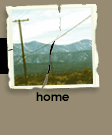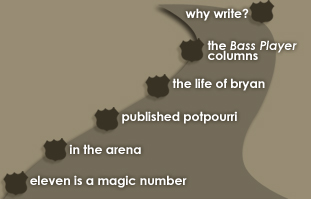
 |
|||||||||
|
|
|||||||||
| Sign up for BellerBytes, the official (and private) Bryan Beller e-newsletter. Just click here to sign up. Do it, OK? | |||||||||
|
Bass Player Magazine Masterclass: NOTE: This article contains references to transcribed musical examples not listed in this reprinting. Click here to see the article on Bass Player's website. For bassists who aspire to play challenging music, there is usually a Holy Grail - a song that requires a level of technical mastery and theoretical understanding that lies just out of reach. For me, that song has always been John Patitucci’s “Scophile” (Sketchbook, GRP, 1990), a near-impossibly fast jazz-fusion blowfest in tribute to one of his influences, John Scofield. The honoree himself played on the track, along with John Beasley on keys and drummer Vinnie Colaiuta. Four masters, 276 beats per minute, no brakes. And six bass strings, no less. A Berklee-era attempt to play the tune live left my hands in pain and my ego in ruin. For a brief, shining moment in my senior project two years later, I could play most of it, but I never really got it. Not being a true jazz musician, it simply sounded “out” to me, which was why I loved it so much. An authentic, child-like how did they do that? aura existed with it. Thirteen years later, with countless other complex tunes under my belt, this one remained a mystery. Would I need a codex and a “professor of symbology” to crack it? Then, this spring, I found myself scribbling frantically while on the phone with John Patitucci himself, as a conversation I thought would be about scheduling an interview regarding this song turned out to be the interview. He spoke at a tempo befitting the tune: molto vivace. “I was a big student of John [Scofield’s] style, and I was working on making diminished more melodic,” he started. He then exampled John Coltrane’s ability to make music that was complex, yet alive and breathing. But why such a complex tune to begin with? And one so difficult to play on a bass? “My style of playing speaks the language of jazz. It was natural - music that I was passionate about.” This is natural for him? I silently gasped. Then, on technique, he offered, “People tend to write things that lay under their hands, and this was written around what’s comfortable for me to play.” Great, I’m thinking. For some of us it’s “Whole Lotta Love” and for him it’s this? We went over my transcription, which covered the reprise of the head at the end of the tune. Not bad, only three notes to fix. But I still didn’t get it, and time was slipping away. Finally, ten minutes into the conversation, and 15 years after the tune first baffled me, he let loose the secret. “It’s all wrapped in the A half-whole diminished sound. Think about the major and minor arpeggios in the scales. You get melodic skyscrapers of sound, but there’s mystery to it. It sounds like music as opposed to just a bunch of scales and licks.” It suddenly, completely popped for me. On the rare occasions I even thought about using that scale and tonality, I’d just play a portion of a half-whole diminished scale and quickly retreat to safer harmonic ground. In Patitucci’s world, this was “obvious.” He wasn’t working on obvious. He was working on making diminished more melodic. I looked at my transcription. The head melody, with its half-whole motion and scale-related intervals, suddenly came alive on the screen. The arpeggios in the B section looked like skyscrapers, alright. Big, fat, ‘A’-half-whole-diminished-tonality skyscrapers. I got it. The code was cracked, the secret revealed. But now I was right back where I started. Can it be played? Perhaps, but what occurs naturally under the hands of John Patitucci may not occur naturally for us mortals. Regardless, he strongly recommends not starting with the tablature (“Read the music!” I recall him declaring.) So, again, can it be played? Maybe so, maybe not. But at least now we know where to start looking. By Bryan Beller, copyright 2006 United Entertainment Media. Reprinted from the July, 2006 issue of BASS PLAYER. Reprinted with permission from BASS PLAYER. For subscription information, please call (850) 682-7644 or visit www.bassplayer.com |

|